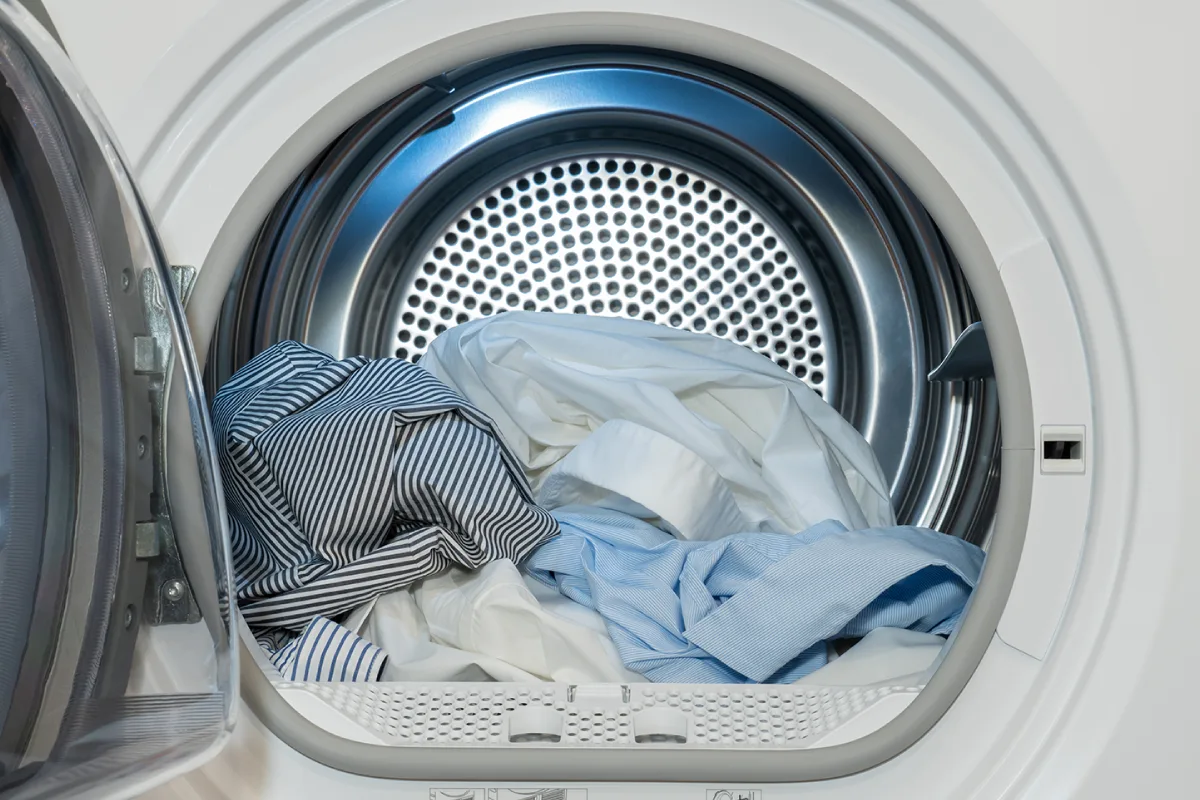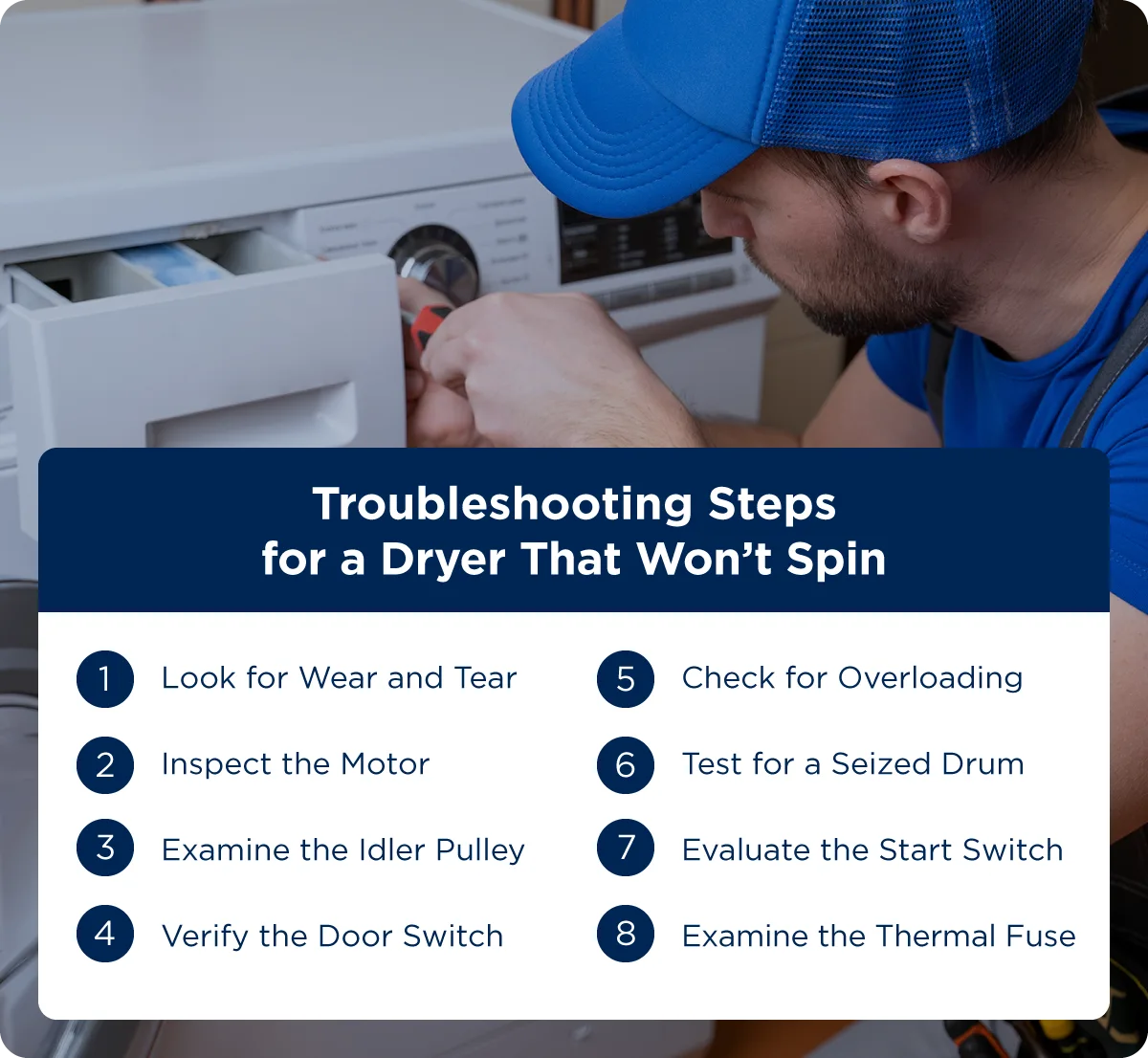11 Reasons Your Dryer Won’t Spin [+ How to Fix It]

|
A clothes dryer won’t spin due to a broken drive belt, worn drum rollers, or a faulty motor, all of which are critical components for drum movement and require immediate attention or replacement to resolve the issue. |
There’s nothing worse than finally getting around to washing that mountain of dirty clothes in your closet only to realize your dryer won’t spin. Understanding the reasons behind this mechanical hiccup is crucial as we rely on these appliances to maintain our household routine.
Whether you're a DIY enthusiast or seeking insights before calling in the professionals, unraveling the mystery behind your idle dryer will save you time and money and restore the seamless flow of your laundry routine. In this blog, we will dive into the common culprits behind a non-spinning dryer and explore potential issues — from simple fixes to more complex repairs.
1. Broken Driver Belt
Broken driver belts are a frequent cause of malfunctioning dryers — after all, they are the primary component enabling drum rotation.
The driver belt connects the dryer’s motor to the drum. When this belt fails, the drum loses its driving force, causing it not to spin. A tell-tale sign of a broken dryer belt is a noticeable thumping sound during operation, as the belt flails unsuccessfully in its attempt to turn the drum. You may also see the driver belt loose or completely detached behind the dryer.
2. Worn Drum Rollers
The drum rollers and glides allow the drum to rotate smoothly. Over time, these rollers can wear down due to constant friction, creating resistance that can overload the motor and keep your dryer from spinning.
If you notice a persistent squeaking or grinding noise while your dryer is on, it’s likely due to worn drum rollers. A thorough inspection can reveal flattened or visibly worn areas on the rollers, indicating that they have reached the end of their operational life and need replacing.
3. Worn Roller Axles
Roller axles are the shafts on which the drum rollers are mounted, facilitating the smooth movement of the drum as it turns. Like drum rollers, roller axles experience wear and tear from constant friction and eventually need to be replaced.
In addition to your dryer not spinning, signs of worn roller axles include:
- Increased friction or resistance causes the drum to drag.
- Signs of rust, damage, or irregularities in the axles themselves.
- Wobbling or misalignment of the drum.
4. Faulty Motor
The dryer motor is responsible for initiating the drum's rotation, and when it fails, the entire spinning mechanism is compromised.
If you’re dealing with a faulty or broken dryer motor, you may experience:
- Your dryer is not spinning
- A humming noise comes from the motor as it struggles to engage
- A burning smell around the motor area indicates overheating or internal damage
- Your dryer shutting off completely in the middle of a load
5. Worn Drum Bearing
A worn drum bearing can be the culprit behind your dryer not spinning, as it plays a crucial role in supporting the drum’s rotation. The drum bearing is a circular support structure that allows the drum to turn smoothly within the dryer. Over time, continuous use can lead to wear and tear on the bearing, resulting in friction that hinders the drum from spinning.
Signs that you may need to replace a worn drum bearing often include:
- A squeaking or grinding noise
- Excessive wobbling when the drum is manually rotated
6. Idler Pulley Failure
The idler pulley is a small yet critical component that maintains tension on the dryer belt, ensuring it stays connected to the motor pulley and enables the drum’s rotation. When the idler pulley malfunctions, it can lead to a loose or slackened belt, ultimately resulting in a non-spinning dryer.
If you’re experiencing any of these symptoms, it could be a broken idler pulley:
- Squealing or squeaking during operation
- Irregular resistance when manually rotating the drum
- A loose or visibly damaged belt
7. Faulty Door Switch
Although less common, a failed door switch can cause your dryer to malfunction. The door switch in a dryer is a safety mechanism that ensures the drum only operates when the door is securely closed. If the door switch fails, the dryer may perceive an open door even when it's closed, leading to a disruption in the spinning cycle.
If your dryer isn’t starting when the door is closed, try applying some pressure to it. If the dryer turns on, the issue is likely the door switch. Additionally, if the interior light stays on even when the door is shut, it’s likely an indicator of a faulty switch.
8. Overloaded Drum
Stuffing your dryer to the brim can significantly impact its ability to spin efficiently. The drum is designed to handle a specific laundry capacity, and exceeding that limit can strain the motor and belt, leading to operational issues.
If you’re experiencing any of these signs, you’re probably overloading your dryer:
- Drying times taking longer than usual
- Clothes coming out damp and wrinkled
- Unusual noises during operation, such as thumping or banging
- Uneven drying
If you want to improve the performance and extend the life of your dryer, It's crucial to adhere to the manufacturer's guidelines regarding load capacity.
9. Seized Drum
Your dryer drum may become stuck if there’s an issue with any support components, like the drum rollers or rolling axles. When the drum seizes, the motor may struggle to overcome the resistance, making your dryer not spin.
If you’re noticing a distinct lack of drum movement during the drying cycle, try physically rotating the drum by hand to reveal the extent of the issue. A properly functioning dryer drum should move relatively easily — if you encounter resistance or find it challenging to turn the drum manually, the drum may have seized.
10. Faulty Start Switch
The start switch initiates the motor and drum movement when engaged — if this switch fails, it can disrupt the entire spinning process.
You may have a faulty start switch if:
- The dryer is not responding or showing any signs of activity when you press the Start button.
- The switch feels loose or unresponsive, indicating an internal electrical issue.
Additionally, if the dryer starts intermittently or requires multiple attempts to kick into action, the start switch could struggle to provide a consistent electrical connection.
11. Tripped Thermal Fuse
The thermal fuse protects your dryer from overheating. If it detects excessively high temperatures, it will interrupt the electrical circuit and prevent your dryer from finishing its cycle.
A tripped thermal fuse is often an indicator of other underlying issues, such as:
- Restricted airflow: Poor ventilation due to clogged or blocked vents, lint filters, or ducts can lead to insufficient airflow, causing the dryer to overheat.
- Overloading: Overloading the dryer with excessive clothing can strain the heating element and other components.
- Malfunctioning thermostat: A faulty thermostat may fail to regulate the dryer's temperature effectively, leading to overheating and triggering the thermal fuse as a safety precaution.
- Defective heating element: If the heating element is malfunctioning or has a short circuit, it can cause the dryer to overheat.
- Faulty cycling thermostat: The cycling thermostat maintains the desired temperature inside the dryer. A malfunctioning cycling thermostat may result in inconsistent temperature control.
If your dryer has turned off in the middle of a load, try turning it on again. If the dryer is completely unresponsive, the thermal fuse has likely interrupted the electrical flow to the motor. You may also notice that the dryer drum light is off, indicating a lack of power.
How to Fix a Dryer That Won’t Spin

A non-spinning dryer can throw a serious wrench into your laundry routine. However, before calling in professional help, you can take several troubleshooting steps to identify and potentially fix the issue yourself:
- Look for wear and tear. Examine the condition of the dryer belt, drum rollers, roller axles, and drum bearing for signs of wear, detachment, or damage. You can replace these components yourself by following the manufacturer’s instructions. If you notice significant wear and tear in an older dryer, it may be time to replace it.
- Inspect the motor. Investigate the motor for signs of failure, such as unusual noises, humming, or a burnt smell. If you suspect the motor is the cause of your dryer issues, it’s best to seek professional help for repair or replacement.
- Examine the idler pulley. Assess the idler pulley for functionality and tension on the dryer belt. Lubricating or replacing the idler pulley can usually be done without professional help.
- Verify the door switch. Ensure the door switch is functioning correctly and allowing the dryer to start. If the door switch is faulty, replacing it is a relatively straightforward task — just make sure the dryer is unplugged before attempting any repairs.
- Check for overloading. Avoid overloading the dryer, as excessive weight can strain the motor and belt.
- Test for a seized drum. Check if the drum is seized by attempting to rotate it manually. If it’s difficult to spin or won’t spin at all, you may need to go back to step 1 and re-evaluate the support components.
- Evaluate the start switch. Test the start switch for proper engagement and responsiveness. If the dryer fails to turn on despite being plugged in, it may be a wiring problem that only a service professional should attempt to fix.
- Examine the thermal fuse. Investigate if the thermal fuse has tripped, preventing the dryer from turning on. If the thermal fuse has tripped due to overheating, identify and address the root cause (such as a clogged vent) and reset the fuse.
If you’ve gone through the entire troubleshooting process and still can’t figure out what’s causing your dryer to not spin, it could be a sign of a more serious problem. In this case, contact a qualified service professional to ensure your dryer is in good hands.
FAQ About Dryer Repair
We understand that a malfunctioning dryer can disrupt your daily routine, and quickly finding the right solutions is crucial. Whether you're dealing with a non-spinning drum, unusual noises, or issues with heat distribution, this FAQ guide aims to provide clear answers and guidance to help you diagnose and resolve common dryer problems.
How Do I Know If My Dryer Belt Is Broken?
If your dryer belt is broken, you may notice your drum is not turning, and your clothes are taking longer to dry. Check the belt for fraying, cracks, or detachment to confirm it’s broken and needs replacing.
Will A Dryer Turn On If The Thermal Fuse Is Blown?
A dryer typically will not turn on if the thermal fuse is blown. The thermal fuse is a safety measure that prevents the dryer from operating when there's a risk of overheating. If the thermal fuse is blown, it cuts off power to the dryer and renders it inoperable until the fuse is replaced and the underlying issue is addressed.
How Do You Reset a Dryer?
Dryers don't usually have a traditional reset button, but you can perform a "soft" or "hard" reset by following these general steps:
Soft reset:
- Turn off the dryer and unplug it from the power source.
- Wait for a few minutes to allow any residual power to dissipate.
- Plug the dryer back in and turn it on.
Hard reset:
- Locate the circuit breaker or fuse box connected to your dryer.
- Turn off the circuit breaker or remove the fuse corresponding to the dryer's electrical circuit.
- Wait for about 30 seconds to 1 minute.
- Turn the circuit breaker back on or replace the fuse.
- Plug the dryer back in and turn it on.
These steps might vary depending on the dryer model, so it's a good idea to consult the user manual for your appliance for more accurate instructions. If the issue you're trying to address with the reset persists, contact a service professional for assistance.
Can You Still Use a Dryer If It Won’t Spin?
If your dryer won't spin, the short answer is no. The spinning action is crucial for properly drying clothes, ensuring they tumble and get evenly exposed to heated air. If the drum doesn't spin, your clothes will not dry.
Diagnosing and addressing the problem causing the lack of spinning is recommended before attempting to use the dryer again.
Dryer Still Won’t Spin? Mr. Appliance Can Help
If you have tried all the troubleshooting steps and your dryer still won’t spin, it’s time to call an appliance repair expert. There could be other issues going on related to faulty electrical components or other intricate parts of the dryer. Problems like these should be safely diagnosed and repaired by a trained professional.
Mr. Appliance has the qualified and courteous service professionals you need to get your dryer spinning again. Our local teams offer up-front pricing, flexible scheduling, guaranteed quality parts, and quality work.
Dirty laundry may pile up fast, but your frustration doesn’t have to. Call Mr. Appliance today to schedule service online to fix your broken dryer.
This article is intended for general guidance only and may not apply to every situation. You are responsible for determining the proper course of action for your property and your situation. Mr. Appliance is not responsible for any damages that occur as a result of any advice or guidance derived from blog content. For the most accurate guidance, contact an independently owned and operated Mr. Appliance business for a professional custom and on-site assessment.
 Click to call
Click to call


